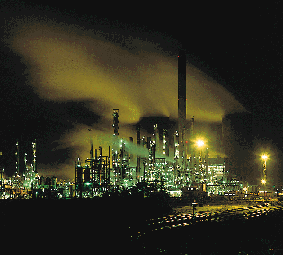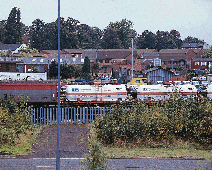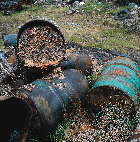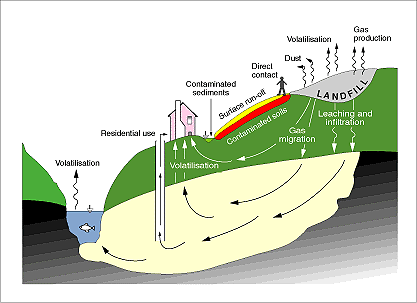|
Chapter 7: The application of environmental risk assessment in industry
|

Martin Bond, Environmental images
|
This chapter of the book outlines the major ERA methods used in European Industry. It examines ERA used for non-routine industrial releases, routine industrial releases, transportation risks, financial risks, the risks posed by chemicals and products, risk minimisation and reduction decision-making, and specific industrial applications such as contaminated land and land-use planning. As most activity in industry addresses non-routine accidental releases and product/chemical risk assessments, these are the major focus of the chapter. Little work is carried out by industry itself on ERA of routine releases other than emission modelling for licences, as this is not yet a legislative requirement. Routine releases are restricted and controlled by regulators applying concepts such as Integrated Pollution Prevention and Control, Best Practicable Environmental Option, and Best Available Technology (Not Entailing Excessive Costs).
|
7.1 Site-Specific ERA for Non-routine Releases
The principles of ERA for non-routine accidental releases are to identify the hazard and the release scenario, to analyse the effects or consequences and, if necessary, to provide a quantitative estimation of the event probability and compare it with agreed criteria. This will lead to risk acceptance or the implementation of risk reduction measures that reduce the likelihood of the event or reduce the consequences to a satisfactory level.
The risk assessment process consists of several steps:
- Hazard Identification/Release Assessment: using tools such as hazard indices, Hazop, event tree analysis, failure mode and effect analysis and many others to determine the nature of potential hazards and the likelihood of a release(software, databases);
- Exposure Assessment attempts to determine the magnitude of the physical effects of an undesirable event (identified in the hazard identification and release assessment stages), and the pathways and transport modes of the hazard to the receptor, using predictive exposure modelling tools for aerosols, thermal radiation, vapour cloud explosions etc...(software)
- Consequence Assessment attempts to quantify the possible damage to the receptor, caused by the exposure to the hazard, using vulnerability models (software);
- Risk Estimation consists of integrating the estimation of the probability of release events with the results of the consequence assessment to produce an estimate of the overall risk of an activity.
The corporate risk assessment programme for non-routine releases addressing public safety developed at BOC is presented as a case study.
7.1.5 The extent of ecological risk assessment in site-specific ERA for non-routine releases
The use of ERA for ecological risks is in its infancy. It is performed by some environmental leaders, mainly the large multi-national chemical and petro-chemical companies, but its use in small to medium sized businesses is very limited. Hazard identification, release assessment and exposure assessment can be carried out as for human health risk assessment but specific effects and impacts are not known. The risks of a release to the environment though can be assessed and reduction measures put in place. The implementation of an Environmental Management System should reduce the risk of a major accident occurring which may result in damage to the environment. Companies are now extremely aware of the risks associated with the running of a facility without adequate release prevention systems or equipment in place. The penalties for causing environmental contamination can be severe.
7.2 Site-specific ERA for Routine Releases
Essentially companies are not required to assess the risks posed by their routine emissions. They are required to comply with emission and effluent discharge standards based on principles such as BATNEEC. The consequences of non-compliance are significant and responsible companies seek to minimise the risk of such an occurrence. Many companies adopt a proactive approach with the intention of staying one step ahead of legislation and set their own internal standards which are higher than the regulators'. Some adopt the precautionary principle and attempt to reduce emissions to the minimum that is technically possible.
7.3 Transportation Risk Assessment
|

Martin Bond, Environmental images
|
Significant quantities of hazardous substances are transported by road, rail and pipeline. Various tools such as Transport RISKAT, have been developed to enable the risks associated with modes of transportation to be assessed and managed effectively. The book describes this tool and also provides a case-study of the application of risk assessment to the tank truck transportation of chemicals and petroleum products.
|
7.4 Financial Planning
Companies in a variety of industrial sectors are increasingly using risk assessment as a tool to manage their liabilities. Risk assessment has long been a part of the process of financial decision-making, but it is only relatively recently that it has been used in the context of translating the impact of accidents (on humans and the environment) into financial terms. The book describes one method termed Integrated Financial Risk Assessment (Geyer and Morris, 1996) which facilitates the comparison of various consequences and incorporates the total cost of incidents to obtain a true financial liability of the undesired event. The approach enables sound financial decisions to be made on the extent of risk reduction measures by ensuring the cost of risk reduction is relative to potential liability costs. A financial risk case study is provided.
7.5 Product Risk Assessment and LCA
Many companies conduct risk assessments on their products or components of their products. This is a well established procedure for food, medical, pharmaceutical and chemical products, necessary to reduce the risks to a minimum of harm occurring to an individual through consumption of a particular food or drug or from using a chemical such as a pesticide.There are established programmes in place under EU legislation to address the risks from new and existing chemicals. Companies involved in such programmes include BASF and GlaxoWellcome.
Due to increasing public concern over the use of toxic substances in products and possible human exposure, manufacturers also address the risks to humans and the environment posed by their products incorporating a life-cycle approach, particularly emphasising the use and disposal phases.
The book provides a comprehensive case-study of the risk assessment methodology deployed by Procter and Gamble and discusses the relationship between risk assessment and Life Cycle Assessment.
7.6 Risk Minimisation and Reduction Measures
If the results of an ERA for a given scenario suggest that the risks are too high, a risk management decision needs to be made. This will result in the implementation of some form of risk reduction strategy such as a reduction in inventory of certain materials at a site, the re-design or modification of a particular section of a plant, the re-routing of a tank truck or selection of a different mode of transport.
It may not be necessary to carry out a comprehensive risk assessment, a hazard assessment may be sufficient involving hazard identification and suitable measures to reduce the risk of the substance being released to an absolute minimum through appropriate design and the use of Hazop, strict safety procedures and effective employee training.
A case-study of a risk reduction programme at a GlaxoWellcome site is provided in the book.
Non site-specific chemical reduction programmes are very important. The ongoing work of major international organisations such as the EU, OECD, IPCS and FAO is at the core of the quest for comprehensive information on chemicals and the development of effective management strategies for their "safe" use.
7.7 Risk Assessment Techniques Developed for Specific Industrial Application
In addition to the risk assessment techniques developed for industrial processing sites, techniques have been adapted to cope with very specific industrial scenarios. The book briefly describes those techniques used for offshore installations (7.7.1), nuclear installations (7.7.2), and land-use planning adjacent to hazardous sites (7.7.3). Techniques used for contaminated land and waste management are given lengthier treatment.
7.7.4 Contaminated Land
|

|
Risk assessment is used to prioritise sites and to set action and clean-up criteria for contaminated land. The objective is to ensure that land is made safe for re-use without presenting a long-term environmental liability.
Robert Brook, Environmental images
|
The assessment of contaminated land is a complex business due to the complex nature of soil itself and the myriad of possible contaminants from various industrial and waste disposal processes that can be distributed within it. For this reason and many others, respective to different countries such as land use, legal and administrative systems, land ownership and industrial histories (Visser, 1995), countries have pursued their own policies in regard to the contaminated land problem. Although differences exist, most countries use a criteria-based approach and common, key issues are addressed in each policy formulation as suggested by Visser (1995):
- Which risk level is acceptable or tolerable and which level of human and environmental protection is desirable or reasonably achievable?
- Is it preferable to use generic clean-up criteria or a strictly site-specific approach?
- Should generic soil quality criteria and clean-up criteria be related to intended land use?
The book discusses the pros and cons of the various approaches and outlines a methodology for site-specific assessment proposed by Ellis and Rees (1995). An example of the use of risk assessment in the prioritisation of sites for remediation is provided (British Gas) and the collaborative work of European organisations such as CARACAS and NICOLE is outlined.
7.7.5 Waste Management
Concern over the possible human health effects, resulting from exposure to hazardous substances disposed to landfill sites, has driven the need for the application of risk assessment to such scenarios. Particularly of concern is the fact that existing hazardous waste sites may not have been designed with sufficiently preventative considerations for human health or the environment in mind.
The requirement, therefore, is to carry out risk assessments on a site-specific basis with the objective of determining the risks to which the human population and the environment are exposed. It is also possible and desirable to include risk assessment in the design process and planning stage of future disposal sites.
The book describes a methodology for assessing the risks posed by a hazardous waste disposal site (Petts and Edulgee, 1994). This includes hazard identification, hazard analysis (including release and exposure assessment (Figure 7.10), risk estimation and risk evaluation. An example of a risk assessment method used at the design stage of a landfill is provided.
|
Figure 7.10
Conceptual model of landfill exposure sources and environmental pathways (source - Petts, J and Edulgee, G. Environmental Impact Assessment for Waste Treatment and Disposal Facilities. p 229. John Wiley and Sons, Chichester. 1994)

|
References for the chapter
Many of the sections in the Information Sources are relevant to this chapter but particularly:
Databases
Directories (environmental consultants)
Software Models
Publications (Books)
|


Document Actions
Share with others